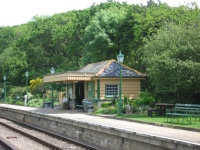Harman's Cross Railway Station's Cross
This has to be one of the quaintest railway stations in England.
But is there a cross at Harman's Cross?
Harman's Cross Railway Station
The main station shelter (see photo) is classic 1930s style but surprisingly it was not built until 2002. Even more unusual is that the building was constructed by volunteers and that's because the whole Swanage Railway line is operated by serious hobby enthusiasts. As for explaining the origin of the name 'Harman', and its cross, that's not so easy.
There's no notable family named Harman in Harman's Cross village, which is three miles west of Swanage in the Thomas Hardy part of southern England (see map). No cross can be seen at the railway station, neither is there a Village Cross. (There isn't even a church in the area.)
Harman
There are several legends surrounding the naming of Harman's Cross. One tells of a murderer named Harman, who was hanged from a tree at the crossroads; although why a village would want to be named after a murderer's execution is a mystery.
Certainly Harman has been an English family name since the late Middle Ages, possibly originating from a 'man who had grey hair'. An Old English term for 'grey or white with age' is 'hoary', and 'hoary man' could conceivably have evolved into 'Harman'. Contrary to popular belief, however, life expectancy even before the Middle Ages in England (of those who made it through childhood) was not much younger than it is today. In other words, a grey-haired man wouldn't have been unusual enough to warrant naming him as such.
In northern Europe, way back in the 1st century, was a chieftain called Arminius, who stopped the Roman army's advance beyond the Rhine. His name lived on in the German 'Hermann', which means soldier. In 793 AD Danes and Norsemen landed at Portland, not far from the present day Harman's Cross. This was the beginning of two hundred years of Viking encroachment into southern England. So it's possible that the first Harman was a German immigrant who farmed the area.
Or 'Harman' might be named after something else. If you have a theory, please let us know.
Cross
The 'Cross' could be the crossroad junction in the centre of the village where Haycraft's Lane meets Valley Road. However, Haycraft's Lane is a relatively minor road compared to Valley Road and it seems unlikely the crossroads would have had sufficient significance to warrant such naming. In fact there's no major road crossing or river crossing, so we prefer an alternative explanation:

Valley Road is an ancient low-lying path between the fishing port of Swanage and Corfe Castle, which guarded the gap in the Purbeck Hills ('Corfe' is the Saxon word for 'gap'). Burial mounds near Corfe Castle date from 6000 BC and the strategic importance of minding the gap was recognised by chieftains and kings for thousands of years.
The Celtic Durotriges tribe lived there and traded with the Romans when they invaded in the 1st century and there's evidence of a fort when the Normans invaded 1,000 years later. The ruins of Corfe Castle visible today date from Henry I (11th century) and it remained a royal castle until Elizabeth I (16th century).
During that period, how many serfs would have been sent six miles down the road to the fishing port of Swanage for some fish'n'chips? There were many monasteries in Dorset, although none are believed to have been in the immediate vicinity. But it's not unreasonable to suppose that some sort of rest area might have been provided for travellers on the Valley Road. Monasteries were powerful owners of vast tracts of land until Georgian times. One of their responsibilities was to erect Wayside Crosses as location markers and as places for impromptu prayers for a safe onward journey (and perhaps for the collection of tolls).
All conjecture of course. There's no record of any such Wayside Cross, but it's a romantic idea and in tune with the current quaint shelter at Harman's Cross Station.
¶ Other railway stations with 'Cross' in the name
Coincidentally, the neighbouring town of Swanage is currently 'twinned' with Rudesheim en Rhine
